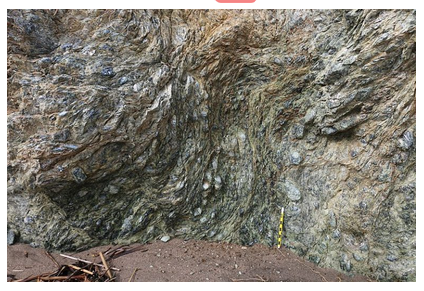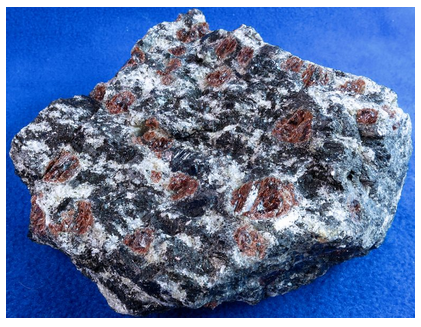8.1.6: Rocks of Different Metamorphic Grade
- Page ID
- 18600
Metamorphic grade is a general term we use to describe the temperature at which metamorphism occurs. Metamorphic grade is important, not just because different kinds of rocks and minerals form at different temperatures, but because temperature affects chemical reaction rates. Rocks metamorphosed at low temperature may change only very slowly, and some changes may not go to completion. Rocks that form at high temperatures generally do not have the same problems. However, there are many kinds of metamorphic rocks, and some of them are more chemically reactive than others.

Low-grade metamorphic rocks form at low temperatures, generally between 150 and 450 °C. They mostly form at low pressures, too. At the lower end of this range, diagenesis overlaps metamorphism. Low-grade metamorphic rocks are often fine grained. Because they are hard to study and frequently do not represent chemical equilibrium, many metamorphic petrologists prefer to study higher-grade rocks. The photo in Figure 8.9 shows a serpentinite, an example of a low-grade metamorphic rock. It contains serpentine and chlorite, both hydrous minerals, that formed during metamorphism of a mafic protolith.
Medium-grade metamorphism, forming at temperatures between 400 and about 600 °C, often produces rocks containing conspicuous metamorphic minerals we can easily see and study. Many schists are medium-grade rocks.

High-grade metamorphic rocks, which form at temperatures greater than about 600 °C, are usually quite coarse-grained and contain minerals easily identified in hand specimen. Most form at high pressures. The high-grade rock shown in Figure 8.10 contains conspicuous centimeter-sized red garnet, black hornblende, and white plagioclase feldspar.
Depending on its composition, a high-grade metamorphic rock may undergo partial melting, also called anatexis, so both metamorphic and igneous processes contribute to its evolution. When this happens, the rock, strictly speaking, is no longer a metamorphic rock. We call the resulting partially melted rocks migmatites, which means “mixed rocks.” For some composition rocks, partial melting may begin at temperatures as low as 700 °C. Other kinds of rocks, especially those that contain little H2O, may remain completely solid to temperatures as great as 1100 °C.


